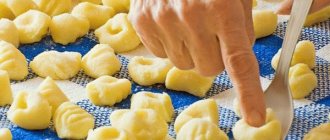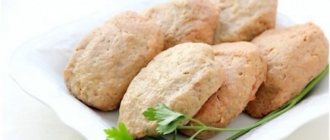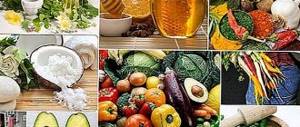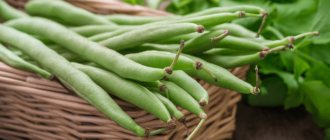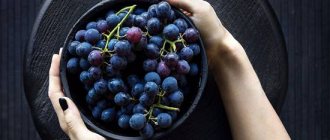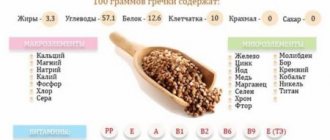- August 18, 2018
- Gastroenterology
- Roman Karpets
Cottage cheese is a very tasty and healthy fermented milk product. It contains a sufficient amount of vitamins, lactobacilli, enzymes, calcium and magnesium salts. In addition, it is rich in easily digestible protein, which has a beneficial effect on the functioning of the digestive system. That is why you should have no doubt whether you can have a casserole made with cottage cheese if you have gastritis. In today's publication you will find several simple recipes for this dietary dish.
Is it possible to eat cottage cheese casserole if you have gastritis?
Gastroenterologists confidently say
that
cottage cheese casserole
is not only tasty, but also
an extremely healthy dessert for the gastrointestinal tract
. The fundamental criterion is the choice of natural and fresh cottage cheese and proper preparation of the dish. When treating gastritis, it is the casserole that can bring some variety to a meager diet. This is due to the fact that it has a number of significant advantages compared to the usual traditional recipes.
According to its characteristics, the casserole
is considered a light
and at the same time very
satisfying dish.
On top of that, it is a delicious and delicious dessert, loved by many patients suffering from gastritis. You can show your imagination and, from various products acceptable for consumption with gastritis, prepare this dessert in various variations.
It is important that this dish effectively relieves hunger, which is why casserole is a fundamental dietary dessert. In order to get enough of it, it is enough to eat only 50-70 grams, so overeating this dish is completely excluded.
Is it possible to use cottage cheese for acute gastritis?
Gastritis, which becomes acute, is accompanied by severe pain, nausea, and a gag reflex. In pathology with high acidity, unpleasant belching and painful heartburn may appear. During an exacerbation, it is important to relieve all accompanying symptoms of gastritis as quickly as possible in order to alleviate the patient’s condition.
Gastroenterologists recommend that their patients fast for a day during an attack, and then introduce mashed potatoes and slimy porridge into the diet. They will be able to eat low-fat cottage cheese only when the pain syndrome and other manifestations of pathology disappear. At the same time, they should thermally treat the fermented milk product before consumption, for example, bake it or cook a soufflé from cottage cheese in a double boiler.
Benefit or harm?
Cottage cheese itself is a storehouse of valuable fermented milk bacteria, which retain their beneficial properties even after heat treatment. That is why all gastroenterologists recommend casserole for inclusion in the diet for gastritis.
After baking, the dish contains sufficient quantities of iron, calcium, fluorine, phosphorus, as well as B-group vitamins, E, A, PP. It is worth highlighting the easy absorption of protein by the digestive tract.
The benefits of cottage cheese casserole for gastritis with high acidity are known.
. This is due to the fact that, together with fats, protein neutralizes hydrochloric acid, which serves as an irritant to the gastric mucosa.
For gastritis, casserole is
almost
an ideal dish
, and there are so many ways to prepare it that you can eat it not only for breakfast and afternoon snack/snack, but also as lunch and a light dinner. Various recipe variations allow you to prepare not only sweet, but also unleavened dessert dishes, while reliably protecting all organs of the digestive system.
For patients with high acidity
Patients with high acidity levels
and those in remission should use
cottage cheese with a low fat content
. It is also recommended to first pass it through a sieve or rub it with a blender. You can cook the casserole either in the oven or in a double boiler/multi-cooker. To improve the taste, experts allow the addition of baked apples or boiled carrots to the cottage cheese.
For patients with low acidity
A reduced level of acidity implies the consumption of foods that stimulate additional release of hydrochloric acid. Therefore, cottage cheese casserole is an excellent solution.
this problem. As a change, you can add a few spoons of low-fat sour cream or honey, as well as fruit puree from baked apples.
Option with rice
We recommend that you pay attention to another interesting recipe for a delicious casserole. If you have gastritis, you can consume all the products included in this dish, so it will appear on your table often. To prepare a healthy dietary treat you will need:
- 450 grams of cottage cheese.
- 15 milliliters of sour cream.
- 45 grams of sugar.
- A pinch of salt.
- 90 grams of rice.
- Egg.
- 15 grams of butter.
Rice is washed in warm water, boiled until tender and cooled. After this, it is combined with pureed cottage cheese, egg yolk, butter, sugar and salt. Separately, proteins are introduced into the resulting mass. All this is kneaded well, transferred to a fireproof form and greased with sour cream. Prepare the dish at two hundred degrees. After half an hour, you will receive a delicious dietary casserole. If gastritis is in remission, the finished dessert can be topped with low-fat sour cream.
Proper preparation
Low-fat cottage cheese or homemade fermented milk product are most suitable for preparation. Before kneading the dough, rub the cottage cheese through a fine sieve. It is recommended to knead the dough very thoroughly to prevent the formation of lumps, and also beat it additionally with a blender.
The approximate baking time is individual, since the softening of the fruits or vegetables included in the composition, as well as the baking of the dough, is influenced by the degree of heating and the characteristics of ovens and steamers.
Serve
The casserole must
only be cooled
, since hot dishes are prohibited for gastritis. To improve the digestion process, it is recommended to add one or two tablespoons of low-fat yogurt or sour cream to the prepared dish.
With low acidity
For gastritis with low acidity, cottage cheese can be included in the menu in any form , including the fresh product. Granular cottage cheese, as in the previous case, is better to rub through a sieve.
You can add a small amount of cream and non-acidic sour cream to the cottage cheese. The product can also be mixed with permitted fruits and berries.
On our website: Dairy and fermented milk products for gastritis - is it possible?
Recipes for making cottage cheese casseroles in the oven
Simple cottage cheese casserole
To prepare the curd dessert you will need:
- 450 g low-fat or homemade cottage cheese;
- 4 tbsp. granulated sugar;
- 3 tbsp. semolina;
- Vanillin on the tip of a knife;
- 3 eggs;
- 50 g sour cream;
- Breadcrumbs.
Preparation:
- Mix the pureed cottage cheese with granulated sugar, eggs, semolina and vanilla.
- Grease a baking dish with vegetable oil and lightly sprinkle breadcrumbs on the bottom.
- Carefully pour the curd mixture into the mold and level the surface, then pour in sour cream.
- Bake in an oven preheated to 180 degrees for about forty minutes.
- After cooling completely, serve, lightly brushing the surface with sour cream.
Fresh cottage cheese casseroles
There are recipes for unsweetened casseroles, where about 250 g of pre-boiled and chopped vegetables and a small amount of salt are added to the dough, mixed using traditional technology. If the kneaded dough becomes too soft, you need to add 1.5 tbsp. breadcrumbs.
As an addition to the curd mass, the following vegetables and herbs are allowed to be consumed:
- ¾ beets;
- ¾ spinach;
- ¾ carrots;
- ¾ zucchini;
- ¾ green peas;
- ¾ pumpkin;
- ¾ parsley, green onions and dill.
Cottage cheese casserole will become a full-fledged, hearty second course if, instead of vegetables, you add lean meat into the dough, grated through a meat grinder. An excellent option for lunch is cottage cheese casserole with the addition of meat, grated cheese and herbs.
It is noteworthy that instead of semolina, many nutrition experts advise using rice porridge. Rice-based dough helps envelop and protect the gastric walls, therefore, cottage cheese casserole with rice is acceptable for use with gastritis.
Cottage cheese casserole: simple and delicious! Cottage cheese casserole is familiar to many from childhood. A delicious cottage cheese casserole is prepared much faster than any cake, while a delicious cottage cheese casserole is much healthier. A mixer or blender will greatly simplify the preparation of cottage cheese casserole; it makes preparing cottage cheese casserole much easier. Cottage cheese casserole recipe
It is found in one form or another in various national cuisines, so the answer to the question of how to make cottage cheese casserole cannot be unambiguous. If you ask an Italian how to make a ricotta casserole, he will tell you a cassata recipe or a ricotta casserole recipe. The Frenchman will tell you how to prepare cottage cheese casserole in the French style. Caucasian - how to make cottage cheese casserole Kluban. American - how to cook cottage cheese casserole.
You shouldn’t be scared by questions like how to bake cottage cheese casserole, how to cook cottage cheese casserole, etc. Making cottage cheese casserole is perhaps the easiest way to prepare a delicious dessert. But not only the recipe for a delicious cottage cheese casserole is important. In order for you to get an airy cottage cheese casserole, the quality of the cottage cheese is of great importance. Cottage cheese for casserole must be natural, fresh, not too fatty, otherwise it may float.
Now about how to bake cottage cheese casserole. The cottage cheese casserole is prepared quickly. Mix cottage cheese, eggs, sugar, flour or semolina, fruits or dried fruits, coat the top with sour cream and bake. This can be done in the oven or slow cooker. Cottage cheese casserole is usually prepared in a frying pan in the oven. Cottage cheese casserole is also prepared in a special form. The recipe is simple but delicious. In addition to the ingredients described above, you can use some pasta to make the cottage cheese casserole more satisfying. It could be a cottage cheese casserole with pasta, a cottage cheese casserole with noodles. But if you are interested in a simple cottage cheese casserole, cottage cheese, sugar and eggs will be enough.
Cottage cheese casserole with fruit has an amazing taste: cottage cheese casserole with pear, with apples, cottage cheese casserole
with raspberries, cottage cheese casserole with strawberries. But even more often, cottage cheese casserole is prepared with raisins or other dried fruits, which are always in stock. Your children will like this curd casserole more than simple cottage cheese.
Lush cottage cheese casserole is prepared simply: you need to make the casserole dough more liquid, beat it thoroughly with a mixer, you can add a little soda or baking powder. 40 minutes in the oven and the tender cottage cheese casserole is ready. If you are on a diet, you will need a dietary cottage cheese casserole - the recipe for cottage cheese casserole without flour is just right for you. It is lower in calories than cottage cheese casserole with flour. The recipe for cottage cheese casserole without eggs has even lower calorie content.
We hope you will find with us a suitable recipe for making cottage cheese casserole and you will learn how to make cottage cheese casserole. And if you still have any questions about how to make cottage cheese casserole, our recipe for cottage cheese casserole with photo (curd casserole with photo) and user comments will answer them.
The calorie content of cottage cheese casserole per 100 grams depends on the recipe and averages 150 - 220 kcal.
The dish is rich in vitamins and minerals, including large quantities of vitamins A, B1, B2, choline, B6, B9, B12, C, D, E, PP, H, minerals potassium, calcium, silicon, magnesium, phosphorus, sodium, chlorine, iodine, iron, cobalt, copper, manganese, selenium, molybdenum, fluorine, chromium, zinc.
The calorie content of cottage cheese casserole with semolina per 100 grams is 215 kcal. 100 g of dish contains 12.9 g of protein, 9.4 g of fat, 20 g of carbohydrates.
The following ingredients are required for preparation:
- 0.4 kg of semi-fat cottage cheese;
- 3 eggs;
- 3 tablespoons of semolina;
- half a glass of sugar;
- salt to taste;
- 1 tablespoon butter;
- 2 g soda.
- eggs are mixed with sugar and cottage cheese;
- add 1 tablespoon of melted butter to the resulting mixture;
- the mixture is salted, mixed with soda slaked with vinegar;
- semolina is added to the egg-curd mass;
- The dough is laid out in a form sprinkled with semolina and baked for 50 - 60 minutes.
Simple recipes
Cottage cheese is included in a large number of dishes, so it will be easy to choose options to suit your taste.
- Sandwich paste. The product is ground until smooth with herbs, spread on slices of dried or day-old bread.
- Lazy cheesecakes. For 300 g of cottage cheese you will need 2 eggs and 100 g of powdered sugar. Separately, soak 3 slices of stale bread in milk, after cutting off the crust. All components are mixed and passed through a sieve. Cover the baking sheet with oiled parchment, form the mixture into balls and place in the oven (160 °C) for 15-20 minutes.
- Syrniki. You will need to boil a glass of rice cereal until half cooked, rinse with water and let drain. Combine rice with 250 g of cottage cheese, 50 g of powdered sugar, beat in 3 eggs and a little salt. The mixture is kneaded and cakes are made. They are placed on a baking sheet covered with paper, greased with yolk and baked at 180 °C until golden brown.
- Souffle. There are several cooking options. Soufflé can serve as a dessert or replace the main course. An oven is suitable for preparing it, but you can use a microwave or double boiler.
- With gelatin. Pour 1.5 tbsp hot water in advance. l. gelatin. While swelling occurs, pureed cottage cheese (300 g) is combined with natural yogurt (150 ml) and powdered sugar (1/2 tbsp.). Add gelatin to the mixture and mix again. The composition is poured into molds and placed in the refrigerator for 7-8 hours.
- With banana. Prepare the mixture: 300 g of grated cottage cheese, mashed two bananas, 50 g of sugar, 2 eggs, 1/2 tbsp. l. semolina. Grease the molds with oil and lay out the mixture. Cooking time is about half an hour, at a temperature of no more than 180 °C. When serving, you can top it with low-fat sour cream.
- With meat. The recipe uses lean boiled meat (150 g). Suitable for these purposes: chicken, turkey, rabbit, veal. It is passed through a meat grinder, mixed with cottage cheese (300 g), salt is added to taste, 2 chicken eggs, 1 tsp. butter, grated cheese (100 g). Goes well with zucchini or pumpkin products. The vegetable is boiled until soft in salted water and mashed into a puree. The mixture is placed in molds and baked for half an hour at a temperature of 180 °C.
- Casserole. The traditional cottage cheese dish is simple to prepare but has an excellent taste. You will need to cook porridge from 0.5 cups of semolina and 250 ml of milk. To the cooled dish add 0.5 kg of cottage cheese, 2 yolks, mashed white with 2 tbsp. l. granulated sugar and a little salt. After mixing, add the whipped whites. The mixture is laid out in the prepared form, the surface is greased with sour cream and baked in the oven (180-200 °C) until golden brown.
Calorie content of cottage cheese casserole in the oven per 100 grams
The calorie content of cottage cheese casserole cooked in the oven is 195 kcal per 100 grams. In 100 g of dish there are 14.1 g of protein, 10.4 g of fat, 11.5 g of carbohydrates.
For cooking you need the following products:
- 0.5 kg of cottage cheese;
- 2 tablespoons of semolina;
- 1 egg;
- 20 g butter;
- salt to taste;
- 30 g sugar.
- cottage cheese is mixed with egg, salt and semolina;
- the baking dish is greased with sour cream and sprinkled with 20 g of melted butter;
- The casserole is baked in the oven at 180° C for 35 – 45 minutes.
High acidity form
The disease is accompanied by increased secretion of hydrochloric acid in the stomach. All foods that have a sour taste are prohibited. It is also necessary to avoid substances that stimulate the secretion of gastric juice.
Before use, the cottage cheese is cooked. There are many recipes for permitted dishes. For example: casserole, airy soufflé, regular or lazy dumplings, cheesecakes prepared in molds, puddings with the addition of fruit puree and cereals. Apples stuffed with cottage cheese and honey, baked in the oven, can be a tasty and healthy dessert.
Insufficient release of hydrochloric acid allows you to consume fresh cottage cheese and various dishes based on it.
The product is thoroughly crushed to eliminate the presence of grains that can cause irritation to the mucous membrane. You can add cream, sour cream, sugar or honey to the mixture. Puree from permitted fruits will help diversify the taste.
Calorie content of dietary cottage cheese casserole in a multicooker per 100 grams
The calorie content per 100 grams of dietary cottage cheese casserole when prepared in a slow cooker is 117 kcal. 100 g of sweet dish contains 12 g of protein, 3.6 g of fat, 9.4 g of carbohydrates.
Ingredients:
- 35 g raisins;
- 10 g fiber;
- 5 g olive oil;
- 100 g eggs;
- 10 g cocoa;
- 150 g 1.5 percent milk;
- 18 g oatmeal;
- 350 g 1.8 percent cottage cheese;
- 8 g poppy seeds;
- 5 g vanilla sugar;
- 90 g banana.
- to prepare the casserole base, fiber, cocoa, egg, olive oil, and oatmeal are mixed;
- the layer of the casserole will be a laid out layer of bananas;
- the upper part of the dish is prepared as follows: cottage cheese is mixed with raisins, poppy seeds, vanilla sugar and banana; a mixture of eggs and milk is added to the resulting curd mass;
- the resulting 3-tier dietary casserole is baked until ready in a multicooker on baking mode.
Beneficial features
Fermented milk product is obtained after fermentation of milk and whey separation. We can say that it concentrated all the beneficial substances. Based on fat content, there are 3 types: fat - with a mass fraction of 18%, semi-fat - 9%, low-fat - no more than 3%. For dietary nutrition for gastritis, it is recommended to choose a low-fat and low-fat variety.
The protein content in 100 g of product ranges from 14 to 18 g, carbohydrates - from 1.8 to 2.8 g. The vitamin set includes the following components: A, B1, B2, C, PP. The mineral composition is represented by iron, calcium, phosphorus, potassium, magnesium, sodium.
One of the advantages of cottage cheese is its ability to be quickly absorbed and not burden the organs of the digestive system.
The rich vitamin and mineral composition promotes the processes in the body:
- growth and restoration of bone and dental tissue;
- maintaining healthy hair and nails;
- strengthening the heart muscle;
- improvement of immunity.
The presence of amino acids normalizes the functioning of the nervous and digestive systems and helps blood formation. Methionine lowers cholesterol levels, thereby preventing fatty liver. The effect on the human body is varied, but is always marked with a plus sign. This confirms the fact that cottage cheese is an integral part of dietary nutrition.
The benefits of cottage cheese casserole
The benefits of the casserole are as follows:
- the casserole contains a lot of phosphorus and calcium, which are necessary for healthy nails, hair, and skeletal system;
- due to the presence of fiber, the casserole is recommended for normalizing metabolism and stimulating digestion;
- the main component of the dish is cottage cheese, which is well absorbed by the body and rarely provokes allergic reactions;
- The casserole is rich in B vitamins, which are important for the health of the heart, blood vessels, and nervous system.
- The dietary dish contains a minimum of calories, therefore it is indicated for weight loss and during a diet.
Useful video
Although when gastritis flares up, there is pain and inflammation in the stomach, in many cases, purely natural therapies and diet can help relieve the symptoms associated with this disease.
Indeed, diet choice plays a very important role in the prevention and treatment of this condition.
So, what foods should you consume to help restore the gastric wall during exacerbation of gastritis?
On the other hand, what foods should be avoided in order to achieve some relief from such an ailment?
To answer all these questions, it is necessary to consider, first of all, the basic principles of proper nutrition in the presence of problems with the gastrointestinal tract.
Harm of cottage cheese casserole
Despite the fact that casserole has many positive properties, in some cases the product can be harmful to health and well-being. Due to the presence of cottage cheese and milk, the dish is contraindicated in case of milk protein intolerance. In addition, you should not overuse casserole if you are prone to flatulence or exacerbations of gastrointestinal diseases.
Mar-19-2013
Casserole is the name given to a dish baked in a frying pan (or in the oven), the ingredients for which are usually finely chopped or used as a puree. The ingredients for preparing the casserole may vary. Today we will talk about such a dish as cottage cheese casserole. Its calorie content interests many of our readers, and this is no coincidence. The fact is that this dish has always been considered one of the key dishes for dietary nutrition. So, let's find out what the calorie content of cottage cheese casserole is, what the benefits of cottage cheese casserole are and what dietary properties it has.
Dietary cottage cheese casserole without flour is one of the healthiest and most delicious dishes made from cottage cheese; it is definitely recommended to include it in your diet. It is perfect for children and adults, and people with digestive problems.
Cottage cheese dishes play a very important role for the growth and development of children, since cottage cheese contains a lot of calcium, protein and is one of the best nutritious foods. And the addition of raisins, rich in vitamins and minerals, to the cottage cheese casserole makes this dish simply ideal for small children. This easy dietary dish will become simply irreplaceable in the menu of people who suffer from hepatitis.
Low-calorie cottage cheese casserole is perfect for those who are on a diet and watching their figure.
Diet for gastritis with erosions on the walls of the stomach
Take care of your health - save the VKontakte link
The appearance of erosions on the walls of the stomach is an advanced stage of development in gastritis. Erosions are dead areas of the stomach.
Gradually it can develop into atrophic gastritis.
The walls of the stomach become thinner, and the amount of enzymes secreted by the internal organs decreases.
The diet for these two diseases is absolutely identical. It is necessary to combine medications and be sure to eat properly for gastritis:
- Hot strong coffee. Sour vegetables and fruits.
- Alcoholic drinks.
- Carbonated drinks.
- Dark chocolate and ice cream.
- Seasonings and spices.
- Large amounts of preservatives.
- Dietary dishes.
- Eggs in any form, but not fried. Fresh fruit jelly.
Dietary properties:
Cottage cheese, the main component of such a casserole, can be consumed even with digestive disorders, since it does not irritate the gastric mucosa and does not increase acidity. Cottage cheese is a rich source of organic acids, as well as minerals: phosphorus, calcium, magnesium. Its vitamin composition is represented by B vitamins, vitamin E, A, PP, N. Cottage cheese dishes are beneficial for the health of nails and hair, for the cardiovascular and nervous systems, and help strengthen teeth and bone tissue.
This is not all the beneficial properties that cottage cheese casserole has. The calorie content of this dish is low and the fat content is low. Thanks to this, the dish can be considered an excellent option for a hearty breakfast; it is also well suited for a light dinner. Cottage cheese casserole is recommended for people who have suffered severe forms of illness, the elderly, as well as those who want to lose extra pounds or, conversely, would like to build muscle as quickly as possible.
Cottage cheese casserole is an indispensable part of the diet for children. Its wonderful taste will not leave you indifferent, and you can add other products to its composition - dried fruits, fresh fruits or berries, at your discretion. The dish can be made so original and unique. You can name many recipes for making cottage cheese casserole, which include spices, vegetables, ham and other ingredients.
Cottage cheese casserole is an excellent dish for those people who do not like to eat cottage cheese in its pure form. When cooked, cottage cheese does not lose its beneficial properties and is also easily absorbed by organisms. The casserole preserves almost all the beneficial substances and vitamins contained in cottage cheese.
There are many recipes for cottage cheese casserole and the calorie content of the dish depends on the ingredients used. The classic cottage cheese casserole consists of cottage cheese, sour cream, eggs and sugar. Some people add flour or semolina to the casserole. These products have a high gluten content and are best avoided.
The average calorie content of a cottage cheese casserole is 150 kcal, but in some cases it can reach up to 250 kcal. The calorie content of the product is affected by the fat content of the cottage cheese, the amount of sugar and other additives. The healthiest casserole is made from homemade cottage cheese, eggs and sour cream. It is quite difficult to find such products in the city. The main thing is that all ingredients have a good shelf life.
When asked what is healthier, cottage cheese or casserole, preference should be given to a natural product. Natural cottage cheese is much healthier than casserole. However, if you add a little variety to your menu in the form of a casserole, it will not harm your health, but even vice versa. In this case, you need to pay attention to the quality and expiration dates of all ingredients.
Features of nutrition for atrophic gastritis
This form of the disease is considered the most insidious. In the absence of a balanced diet and treatment, the consequences can be the most undesirable - even the development of cancer. The secretory glands of the stomach can no longer produce gastric juice. They gradually die off, and new cells appear in place of old cells. Unlike “normal” ones, these cells produce ordinary mucus instead of digestive enzymes. This form of the disease cannot be completely cured. However, strict adherence to the diet and regular treatment guarantee excellent health and long-term remission.
The list of allowed foods is small, but you can eat cottage cheese for atrophic gastritis. True, with one condition: it must be crushed. Sour cream, cream and other dairy products are consumed in limited quantities. To diversify your diet, you can prepare cheesecakes or cottage cheese casserole. Even after heat treatment, the product will not lose its beneficial properties.
How many calories are in cottage cheese casserole?
Now let's clarify what energy value the cottage cheese casserole has. The calorie content of the dish is relatively small; the casserole can be classified as a dietary product. In addition to cottage cheese, its main component, the casserole also includes eggs, sugar, vanillin, and a small amount of semolina or flour. You can experiment with its composition by adding other ingredients. All this in a certain way affects the calorie content of the dish.
Well, what exactly is the calorie content of cottage cheese casserole? and here it is:
What to cook from cottage cheese? Healthy recipes
So, low-fat cottage cheese for gastritis is consumed in its pure form. You can also experiment with different recipes. The following will help you add variety to your usual diet:
- Casserole. A piece eaten for breakfast will quickly satisfy hunger and saturate the body with useful substances without harming the inflamed stomach.
- Curd. Soft, airy. It can be used as a substitute for cheese for sandwiches, or eaten instead of sweets.
- Vareniki. They destroy stereotypes that diet food is always monotonous. They can be eaten with sour cream.
- Cheese pancakes and soufflé will be an excellent replacement for snacks. They will appeal to both adults and the youngest patients.
The calorie content of cottage cheese casserole is approximately 160 kcal per 100 grams of product
If you add, for example, a little raisins, orange zest and dried apricots, then the calorie content can increase to 230 kcal per 100 g. To reduce the calorie content of a dish, you should choose cottage cheese with low fat content or completely low-fat - then the nutritional value will decrease to 140 or 120 kcal per 100 grams, respectively.
What is the calorie content of cottage cheese casserole prepared in different ways? And here it is:
Calorie table for cottage cheese casserole, per 100 grams of product:
And the nutritional value of cottage cheese casserole prepared in different ways is this:
Table of nutritional value of cottage cheese casserole (BZHU), per 100 grams of product:
How to prepare this dish at home? Here is one of the recipes:
Cheese casserole:
Products:
- Cottage cheese – 500 gr.
- Egg - 1 piece
- Ghee butter - 2 tablespoons
- Flour (or semolina) - 2 tablespoons
- Sugar -3 tablespoons
- Salt, vanillin, zest - to taste
- Ground breadcrumbs - 1 tablespoon
Combine eggs with sugar and beat. The cottage cheese is rolled through a meat grinder twice, placed in a bowl, beaten eggs and sugar, salt, flour or semolina, vanillin, zest (lemon or orange) chopped on a fine grater are added. Mix thoroughly. The finished curd mass is placed on a baking sheet, greased with butter and sprinkled with breadcrumbs, leveled, the surface is greased with sour cream, and sprinkled with melted butter. The baking sheet is placed in the oven. The dish is baked for 25-30 minutes.
Before serving, cut into portions, place on plates and top with berry sauce or sour cream. And eat healthy! Moreover, the calorie content of cottage cheese casserole is not so high.
Can it be used during exacerbation of gastritis?
Gastritis is a disease characterized by alternating periods of exacerbation and remission. During the acute form, the patient feels pain and nausea due to heartburn, intestinal disorders, and vomiting. Typically, peaks occur in the spring and summer months, when the carefree season and the abundance of fruits and vegetables cause a person to move away from the diet. In such cases, it is necessary to remember the strictness of the diet and try to correct the situation. In special forms of exacerbation, doctors resort to harsh methods and prescribe fasting.
